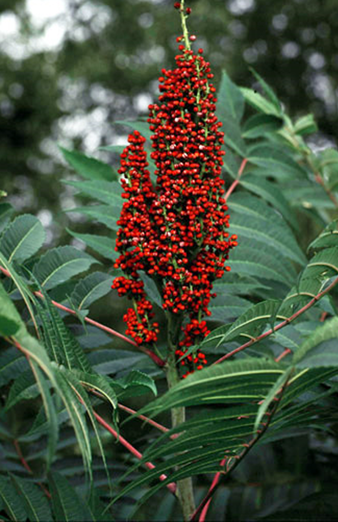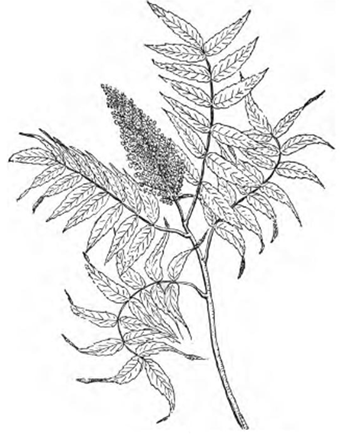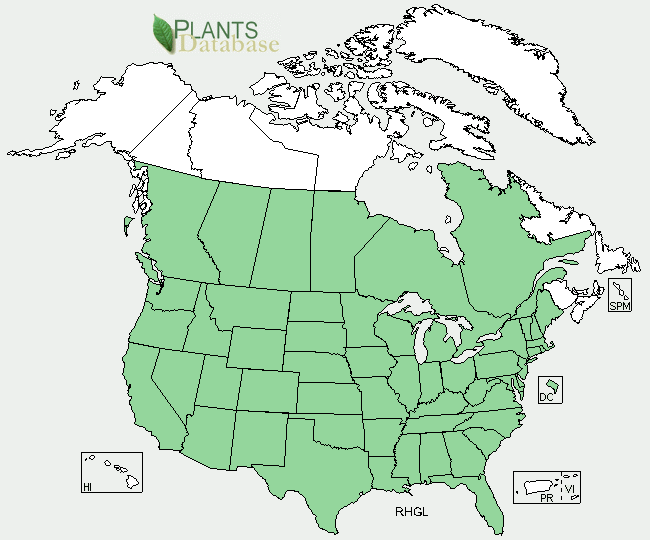Smooth Sumac
(Rhus glabra)

Photo Courtesy Ohio State Weed Lab Archive – Ohio State University

USDA-NRCS Plants Database / Britton, N.L., and A. Brown. 1913.
Smooth Sumac (Rhus glabra):
Named because its first-year stems are smooth, rather than hairy. Ranges throughout the U.S. except for an area in North Dakota and Montana. Can be found as far south as northern Mexico. It establishes on disturbed clearings, hillsides, logged areas, stream overflow, and such disturbed sites as roadsides and reduced-tillage fields. In the Rocky Mountains it grows in stable colonies on mountains, hillsides, and canyons. With the exception of bogs, swamps, and shaded areas, smooth sumac tolerates nearly any condition and type of soil.
A woody perennial usually found in a colony as a shrub or it may grow alone as a small tree. Plants are usually between 2 to 15 feet tall. Has compound leaves composed of many 2- to 4-inch-long leaflets. Leaflets are located opposite each other with a single leaflet located at the tip of each leaf. In summer, leaflets are dark green above and much paler below. Turning a range in colors from orange to scarlet to purple before falling off in the fall. Leaves are shaped like oblong lances, and have coarsely-toothed edges. Its stems are branched and smooth, generally less than 2 inches wide. Branches may be square in cross-section. Bark is thin, smooth, and brownish-gray. Root systems tend to be shallow and wide-spreading. Young shoots are tan to medium brown and hairless. Red fruits, which are covered with minute hairs, form in dense clusters located at the tips of branches.
Flowering begins in June and continues through July. Flowers are small greenish-yellow form 3- to 5-inch long, pyramid-shaped clusters located at the end of stems. Male and female flowers are located on separate trees.
Food :
Native Americans used the Smooth Sumac for beverage and a food item.
• Cherokee Indians used berries to make a beverage; berries are soaked in warm water and filtered two or three times to release acid which is used as a beverage. Filtering is necessary to remove the small hairs found on the berries.
• To make a tea; the seeds have tannic acid which is released into a tea by boiling the berries. Care must be taken to prevent tea from becoming to bitter.
• As a flavoring; wash and filter the berries in fresh water to remove the hairs. Then remove the seeds. Dry and then grind the berries to add a lemon like flavor to meats and salads.
• Young shoots peeled, spring time tips, and shoots from older stumps can be eaten raw or cooked as a vegetable. Shoot stem should be green, there should be no pith, or off white core.
Medical Uses :
Native Americans used sumac as an antiseptic and astringent. Smooth sumac is used to treat a large number of ailments, particularly mouth and throat sores, burns, to control diarrhea, and to promote urination.
• Tea made from either the root or leaves was used to treat diarrhea, dysentery, and mouth/throat ulcers.
• The leaves of the plant were smoked for asthma.
• Chippewa used the flowers to make a mouthwash to ease the pain of teething in children.
• Tea made from the root bark was used to stop hemorrhaging.
Other Uses :
• Native Americans also mixed the leaves and berries of the smooth and staghorn sumac to extend their tobacco.
• The leaves of many sumacs yield tannin and leather tanned with sumac is flexible, lightweight, and light in color.
• Dried leaves are used as a substitute for tobacco
• Fruit is used to make red dyes and the inner bark is used to make yellow dyes.
Warning:
There is a Poison Sumac however it does not look like any of the other Sumac plants. The Poison Sumac is similar in appearance to an alder and has white berries. It is found in wet or swamp areas. Poison Sumac can cause dermatitis in sensitive people.
Distribution





